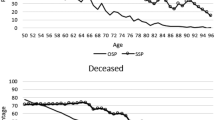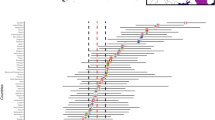Abstract
The purpose of this paper is to investigate whether the choice of household informant for psychological variables included in models of risky household financial behavior matters to the empirical researcher. Five research hypotheses are posited in relation to this purpose, which concentrate on evaluating results from different correlation and regression analyses based on behavior measured at the household level, but with psychological data drawn from either the family financial officer (FFO) or the spouse in family households (N = 807). A sample of one-person households from the same database was used as control group (N = 211).
It could not be shown directly that the amount of explained variance differed significantly between multiple regression analyses, in which the psychological data were drawn from different informants. However, other tests and analyses strongly indicate that including FFO data increased the validity of the model, while the inclusion of spouse data gave a marginally positive, albeit statistically significant, effect. The interpretation of the model also differs when different informants' data are used. One-person household data used to estimate an identical model seemed to produce a better fit than family household data. Finally, measures of "couple" variables showed stronger agreement between spouses than "individual" variables. Zero-order correlations between psychological variables and measures of risky financial behavior differed significantly between spouses in a few cases.
The implication is that in this behavioral domain, psychological data must be collected from the family financial officer, while the spouse can be excluded without any severe consequences. This will also reduce the need to eliminate households from the analysis because of partial non-response.
Similar content being viewed by others
REFERENCES
Amemiya, T. (1985). Advanced econometrics. Cambridge, MA.: Harvard University Press.
Bagozzi, R. P., & van Loo, M. F. (1978). Toward a general theory of fertility: A causal modeling approach. Demography, 15, 301-319.
Bertaut, C., & Haliassos, M. (1992). Precautionary portfolio behavior. College Park, MD: University of Maryland, Department of Economics. Working Paper No. 92-8.
Booth, A., & Welch, S. (1978). Spousal consensus and its correlates: A reassessment. Journal of Marriage and the Family, 40, 23-32.
Brucks, M. (1991). The effects of product class knowledge on information search behavior. In: H. H. Kassarjian & T. S. Robertson (Eds.), Perspectives in consumer behavior, pp. 55-74. Englewood Cliffs, NJ: Prentice-Hall.
Börsch-Supan, A. (1993). Household savings in Germany. Part II: Behavior. Mannheim: University of Mannheim.
Camphuis, H., & Ketelaars, M. (1995). Variable documentation VSB Panel 1993. Tilburg: CentER for Economic Research.
Cohen, J., & Cohen, P. (1975). Applied multiple regression/correlation analyses for the behavioral sciences. Hillsdale, NJ: Erlbaum.
Davis, H. L. (1970). Dimensions of marital roles in consumer decision making. Journal of Marketing Research, 7, 168-177.
Davis, H. L. (1976). Decision making within the household. Journal of Consumer Research, 2, 241-260.
Davis, H. L., & Rigaux, B. P. (1974). Perception of marital roles in decision processes. Journal of Consumer Research, 1, 51-62.
Douglas, S. P., & Wind, Y. (1978). Examining family role and authority patterns: Two methodological issues. Journal of Marriage and the Family, 40, 35-47.
Dowling, G. R., & Staelin, R. (1994). A model of perceived risk and intended risk-handling activity. Journal of Consumer Research, 21, 119-134.
Ferber, R. (1966). The reliability of consumer reports of financial assets and debts. Urbana-Champaign, IL: University of Illinois, The Bureau of Economic Research. Studies in Consumer Savings No. 6.
Ferber, R. L., & Lee, C. L. (1974). Husband-wife influence in family purchasing behavior. Journal of Consumer Research, 1, 43-50.
Gaspinski, J. H. (Ed.) (1993). The economics of saving. Dordrecht: Kluwer Academic Publishers.
Granbois, D. H., & Summers, J. O. (1975). Primary and secondary validity of consumer purchase probabilities. Journal of Consumer Research, 1, 31-38.
Guiso, L., Jappelli, T., & Terlizzese, D. (1994). Income risk, borrowing constraints and portfolio choice. Tilburg: CentER for Economic Research. VSB-CentER Savings Project Progress Report No. 19.
Gujarati, D. N. (1988). Basic econometrics. Singapore: MacGraw-Hill.
Gunnarsson, J. (1996). Use of spouse data in analysis of couple household financial behavior: The case of attitudes towards financial risk taking. Tilburg: CentER for Economic Research. VSB-CentER Savings Project Progress Report 35.
Gunnarsson, J., & Wahlund, R. (1997). Household financial strategies in Sweden: An exploratory study. Journal of Economic Psychology, 18, 201-234.
Hess, T., & Vonk, T. (1988). Developing a new instrument for quantitative research into financial services. In: Research for financial services conference proceedings, pp. 55-74. Amsterdam: ESOMAR.
Hochgürtel, S. (1997). Precautionary motives and portfolio decisions. Tilburg: CentER for Economic Research. VSB-CentER Savings Project Progress Report 48.
Hopper, J. S. (1995). Family financial decision making: Implications for marketing strategy. Journal of Services Marketing, 9(1), 24-32.
Howell, D. C. (1992). Statistical methods for psychology. Belmont, CA: Duxbury Press.
Kamakura, W. A., Ramaswami, S. N., & Srivastava, R. K. (1991). Applying latent trait analysis in the evaluation of prospects for cross-selling of financial services. International Journal of Research in Marketing, 8, 329-349.
Ketelaars, M. (1996). Aggregation of assets and debts. Tilburg: CentER for Economic Research. Mimeo.
King, M. A., & Leape, J. I. (1987). Asset accumulation, information and the life cycle. Cambridge, MA: National Bureau of Economic Research. NBER Working Paper No. 2392.
Kirchler, E. (1988). Household economic decision making. In: W. F. van Raaij, G. M. van Veldhoven, & K.-E. Wärneryd (Eds.), Handbook of economic psychology, pp. 258-292. Dordrecht: Kluwer.
Krampf, R. F., Burns, D. J., & Rayman, D. M. (1993). Consumer decision making and the nature of the product: A comparison of husband and wife adoption process location. Psychology and Marketing, 10(2), 95-109.
Lackman, C., & Lanasa, J. M. (1993). Family decision making theory: An overview and an assessment. Psychology and Marketing, 10(2), 81-93.
Levy, H., & Sarnat, M. (1993). Capital investment and financial decisions. Hemel Hempstead: Prentice Hall.
Lindqvist, A. (1981). Hushållens sparande (Households' saving behavior). Stockholm: The Economic Research Institute at the Stockholm School of Economics.
Lindqvist, A. (1983). Hushållens skuldsättning: En surveyundersökning av omfattning, inställning samt tillförlitlighet i mätmetoderna (Household borrowing). Stockholm: The Economic Research Institute at the Stockholm School of Economics. Studier i ekonomisk psykologi: 118.
Mandell, L., & Lundsten, L. (1978). Some insights into the underreporting of financial data by sample survey respondents. Journal of Marketing Research, 15, 294-299.
McConocha, D. M., Tully, S. A., & Walther, C. H. (1993). Household money management: Recognizing nontraditional couples. Journal of Consumer Affairs, 27, 258-283.
Mitchell, V.-W., & McGoldrick, P. J. (1996). Consumers' risk-reduction strategies: A review and synthesis. International Journal of Retail, Distribution and Consumer Research, 6, 1-33.
Neal, A. G., & Groat, H. T. (1976). Consensus in the marital dyad: Couples' perceptions of contraception, communication and family life. Sociological Focus, 9, 317-329.
Nuckols, R. C., & Mayer, C. S. (1970). Can independent response be obtained from various members in a mail panel household? Journal of Marketing Research, 7, 90-94.
Nyhus, E. K. (1996). The VSB-CentER Savings Project: Data collection methods, questionnaires and sampling procedures. Tilburg: CentER for Economic Research. VSB-CentER Savings Project Progress Report 42.
Nyhus, E. K., Kvitastein, O. A., & Grønhaug, K. (1995). Constructing collective psychological variables at the household level: Some challenges and tentative findings. In: E. Nyhus & S. Troye (Eds.), Frontiers in economic psychology, Vol. II, pp. 577-593. Bergen: Norwegian School of Economics and Business Administration.
Pålsson, A.-M. (1988). Placeringsvalet: Hur svenska hushåll väljer sparform (How Swedish households choose saving forms). Lund: Dialogos.
Pålsson, A.-M. (1996). Does the degree of relative risk aversion vary with household characteristics? Journal of Economic Psychology, 17, 771-788.
Plank, R. E., Greene, R. C., Jr., & Greene, J. N. (1994). Understanding which spouse makes financial decisions. Journal of Retail Banking, 16(Spring), 21-26.
Qualls, W. J. (1987). Household decision behavior: The impact of husbands' and wives' sex role orientation. Journal of Consumer Research, 14, 264-279.
Robertson, A. M. (1991). Spousal decision processes for financial/professional services. Journal of Professional Services Marketing, 6, 119-135.
Rosen, D. L., & Granbois, D. H. (1983). Determinants of role structure in family financial management. Journal of Consumer Research, 10, 253-258.
Safilios-Rothschild, C. (1969). Family sociology or wives' family sociology? A cross-cultural examination of decision-making. Journal of Marriage and the Family, 31, 290-301.
Shuptrine, F. K., & Samuelson, G. (1976). Dimensions of marital roles in consumer decision making. Journal of Marketing Research, 13, 87-91.
Stanley, T. O., Ford, J. K., & Richards, S. K. (1985). Segmentation of bank customers by age. International Journal of Bank Marketing, 3(3), 56-63.
Theil, H. (1961). Economic forecasts and policy. Amsterdam: North-Holland.
Thomson, E., & Williams, R. (1982). Beyond wives' family sociology: A method for analyzing couple data. Journal of Marriage and the Family, 44, 999-1008.
Webley, P. (1994). The role of economic and psychological factor in consumer debt. Tilburg: CentER for Economic Research. VSB-CentER Savings Project Progress Report No. 21.
Author information
Authors and Affiliations
Rights and permissions
About this article
Cite this article
Gunnarsson, J. Cherchez la Femme? Differential Validity in Models of Risky Household Financial Behavior. Journal of Consumer Policy 22, 281–312 (1999). https://doi.org/10.1023/A:1006269608175
Issue Date:
DOI: https://doi.org/10.1023/A:1006269608175




